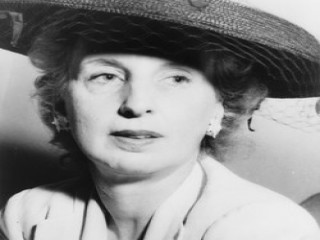
Kay Boyle biography
Date of birth : 1902-02-19
Date of death : 1992-12-27
Birthplace : St. Paul, Minnesota, U.S.
Nationality : American
Category : Famous Figures
Last modified : 2011-06-10
Credited as : Author, The Underground Woman,
0 votes so far
Boyle was educated at the exclusive Shipley School in Bryn Mawr, Pennsylvania, then studied architecture at the Ohio Mechanics Institute in Cincinnati. Interested in the arts, she studied violin at the Cincinnati Conservatory of Music before settling in New York City in 1922 where she found work as a writer/editor with a small magazine.
That same year, she met and married a French exchange student, Richard Brault, and moved to France in 1923. This resulted in her staying in Europe for the better part of the next twenty years. Separated from her husband, she formed a relationship with magazine editor Ernest Walsh, with whom she had a daughter (born after Walsh had died of consumption).
In 1928 she met Laurence Vail, who was then married to Peggy Guggenheim. Boyle and Vail lived together between 1929 until 1932 when, following their divorces, they married. With Vail, she had three more children.
During her years in France, Boyle was associated with several innovative literary magazines and made friends with many of the writers and artists living in Paris around Montparnasse. Among her friends were Harry and Caresse Crosby who owned the Black Sun Press and published her first work of fiction, a collection title Short Stories. They became such good friends that in 1928 Harry Crosby cashed in some stock dividends to help Boyle pay for an abortion. Other friends included Eugene and Maria Jolas. Kay Boyle also wrote for transition, one of the preeminent literary publications of the day. A poet as well as a novelist, her early writings often reflected her lifelong search for true love as well as her interest in the power relationships between men and women. Kay Boyle's short stories won two O. Henry Awards.
In 1936, she wrote a novel titled Death of a Man, an attack on the growing threat of Nazism, but at that time, no one in America was listening. After having lived in France, Austria, England, and in Germany after World War II, Boyle returned to the United States. In 1943, following her divorce from Laurence Vail, she married Baron Joseph von Franckenstein with whom she had two children.
In the States, Boyle and her husband were victims of early 1950s McCarthyism. Her husband was dismissed by Roy Cohn from his post in the Public Affairs Division of the U.S. State Department, and Boyle lost her position as foreign correspondent for The New Yorker, a post she had held for six years. She was blacklisted by most of the major magazines. During this period, her life and writing became increasingly political.
In the early 1960s, Boyle and her husband lived in Rowayton, Connecticut, where he taught at a private girls' school. He was then rehired by the State Department and posted to Iran, but died shortly thereafter in 1963.
Boyle was a writer in residence at the New York City Writer's Conference at Wagner College in 1962. In 1963, she accepted a creative writing position on the faculty of San Francisco State College where she remained until 1979. During this period she became heavily involved in political activism. She traveled to Cambodia in 1966 as part of the "Americans Want to Know" fact-seeking mission. She participated in numerous protests, and in 1967 was arrested twice and imprisoned. In 1968, she signed the “Writers and Editors War Tax Protest” pledge, vowing to refuse tax payments in protest against the Vietnam War. In her later years, she became an active supporter of Amnesty International and worked for the NAACP. After retiring from San Francisco State College, Boyle held several writer-in-residence positions for brief periods of time.
Boyle died at a California seniors home in Mill Valley, California, in 1992. In her lifetime Kay Boyle published more than 40 books, including 14 novels, eight volumes of poetry, 11 collections of short fiction, three children's books, and French to English translations and essays. Most of her papers and manuscripts are in the Morris Library at Southern Illinois University in Carbondale, Illinois. Morris Library has the Ruby Cohn Collection of Kay Boyle Letters and the Alice L. Kahler Collection of Kay Boyle Letters. A comprehensive assessment of Boyle's life and work was published in 1986 titled Kay Boyle, Artist and Activist by Sandra Whipple Spanier. In 1994 Joan Mellen published a voluminous biography of Kay Boyle, Kay Boyle. Author of herself.
Author of books:
Short Stories (1929, short stories)
Wedding Day and Other Stories (1930, short stories)
Plagued by the Nightingale (1931, novel)
Year Before Last (1932, novel)
My Next Bride (1934, novel)
Death of a Man (1936, novel)
Primer for Combat (1942, novel)
Avalanche (1944, novel)
A Frenchman Must Die (1946, novel)
Thirty Stories (1946, short stories)
A Smoking Mountain, Stories of Germany During the Occupation (1951, short stories)
Generation Without Farewell (1960, novel)
Nothing Ever Breaks but the Heart (1966, short stories)
The Underground Woman (1975, novel)
Fifty Stories (1980, short stories)
Collected Poems (1991, poetry)
















